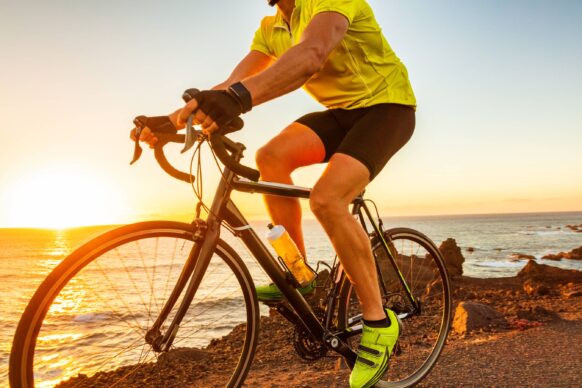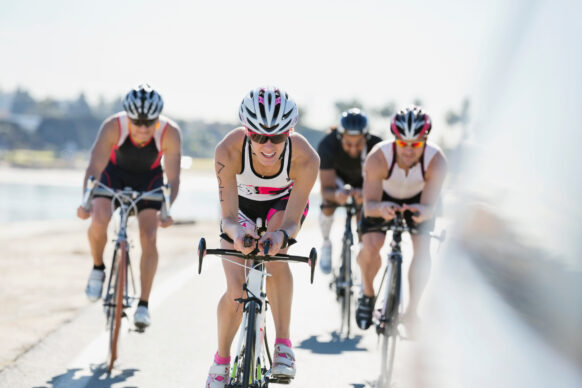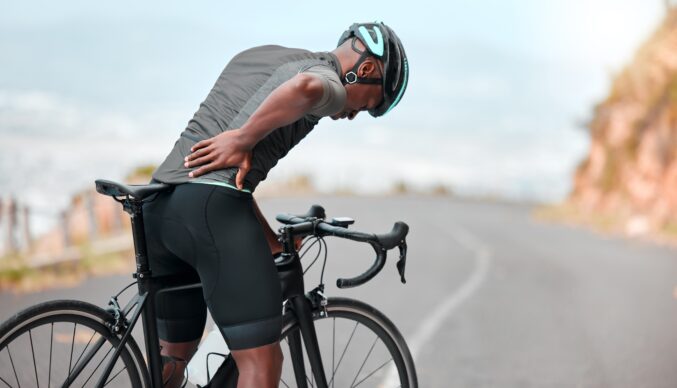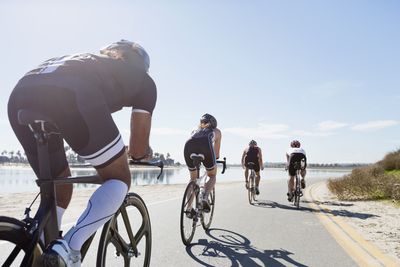By Cory Szostowski PT, DPT, DN-C
Biking – as a way of exercising, commuting and leisure – has been on a steady rise with the statista research department finding that around 51.4 million participated in some form of cycling in 2021. As the number of people enjoying the sport/activity of biking increases, so do the injuries. Biking injuries are usually either nontraumatic (overuse/degenerative), which are the most common, or traumatic (fractures/concussion/abrasions)¹. One of the injuries seen most often in bicyclists is anterior knee pain, stemming from overuse and suboptimal position of the rider on the bike given their unique arthropometrics¹.
A comprehensive assessment should be performed looking at a cyclist’s position and biomechanics at different times in the pedal stroke. The forces through the knee can be modified by raising/lowering the seat, moving it forward/backward, and changing the length of the crank arms. Changes should be made incrementally, to give time for the rider to adjust to the new movement pattern as well as to better assess the effect on the rider’s pain. Saddle height has a major impact on compressive forces put through the patellofemoral joint and alters length-tension relationship of lower extremity musculature². As the seat is lowered, knee flexion increases at the top of the pedal cycle leading to an anterior position of the knee in relation to the foot causing increased pull of the quadriceps on the patella. The best seat height varies between riders, but has been shown to be around 109 percent of inseam or 100 percent from greater trochanter to the ground².
Once a seat height is determined, anterior/posterior alignment of the saddle is the next thing to be considered by looking at knee position when the crank arm is at mid-point of the power stroke³. A slightly anterior position of the knee in relationship with the pedal axles has been found to be the most efficient and minimizes stress across the knee/ligaments². Also, having decreased knee flexion at the bottom of the pedal stroke puts hamstrings/plantarflexors in a better position to contribute during the pedal cycle, decreasing demand on the quadriceps³.
The pedal stroke happens in the sagittal plane, which can lead to muscle imbalances, putting the rider at risk of injury. Areas of typical weakness are the hip adbuctors and core, which can affect knee/pelvic control in the frontal plane leading to valgus alignment of the knee with patellar maltracking, especially during the power portion of the pedal cycle. This, in addition to high mileage or excessive climbing, may lead to anterior knee pain. Below are a few exercises to help manage/prevent anterior knee pain and keep yourself in the saddle all year long.
Sidelying Hip Abduction on Wall
(2-3 sets x 10 reps, each side)
Lay on your side with hips stacked on top of one another and hip/back against the wall to prevent hips from rotating. While maintaining this position, slide the top leg up the wall going a little past parallel with the ground. Be sure you do not rotate your foot upward towards the ceiling. You should feel that burn on the outside of your hip. To increase the demand on the glutes try applying a band around the ankle.
Single Leg Bridge w/ Shoulder Extension
(2-3 sets x 10 reps, each side)
Begin by laying on your back with knees bent and box under feet. Gently draw your belly button down toward the ground to flatten back and then pull the band down from overhead to about shoulder height. While maintaining this position, pick one foot up off of the box and push through the heel of the down leg to lift hips up off the ground. Make sure to keep hips level and not overextend through your lower back. You should feel your glutes/hamstrings working.
Side Plank w/ Row
(2 sets x 10 reps, each side)
Lay on one side with your elbow right under your shoulder and in a straight line from your head to feet. Bend the bottom leg to 90 degrees and keep the top leg straight. Push the bottom knee into the ground to lift up your torso/hip off of the ground and then lift the top leg up towards the ceiling until it is parallel with the ground. Hold position and perform a row with the top arm. You should feel core and glutes working.
Quadruped Fire Hydrants
(2 sets x 10 reps)
On all fours with a band right above knees and a yoga block under one knee, rock pelvis forward/backward to find the most comfortable position for you. Once you find this position, draw your belly button up towards your spine. Using the outside of the hip of the leg that is on the box, pull the other leg up until they are both equal. While maintaining this position, move the unsupported leg out and up without compensating through the lower back.
We hope that you’ll find managing knee pain in bikers and cyclists seems a more attainable goal. If you are feeling pain or discomfort performing these exercises or cycling in general, please schedule a consultation to address it!
References:
- Kotler DH, Babu SN, Robidoux G. Prevention, Evaluation, and Rehabilitation of Cycling-Related injury. Current Sports Medicine Report. 2016; 15(3): 199-206.
- Timmer CW. Cycling Biomechanics: A literature Review. Journal of Sports Physical Therapy. 1991; 14(3): 106-113.
- Evans T, Danoff J. The Internet Journal of Allied Health Sciences and Practice. 2019; 17(3) 1-9.




